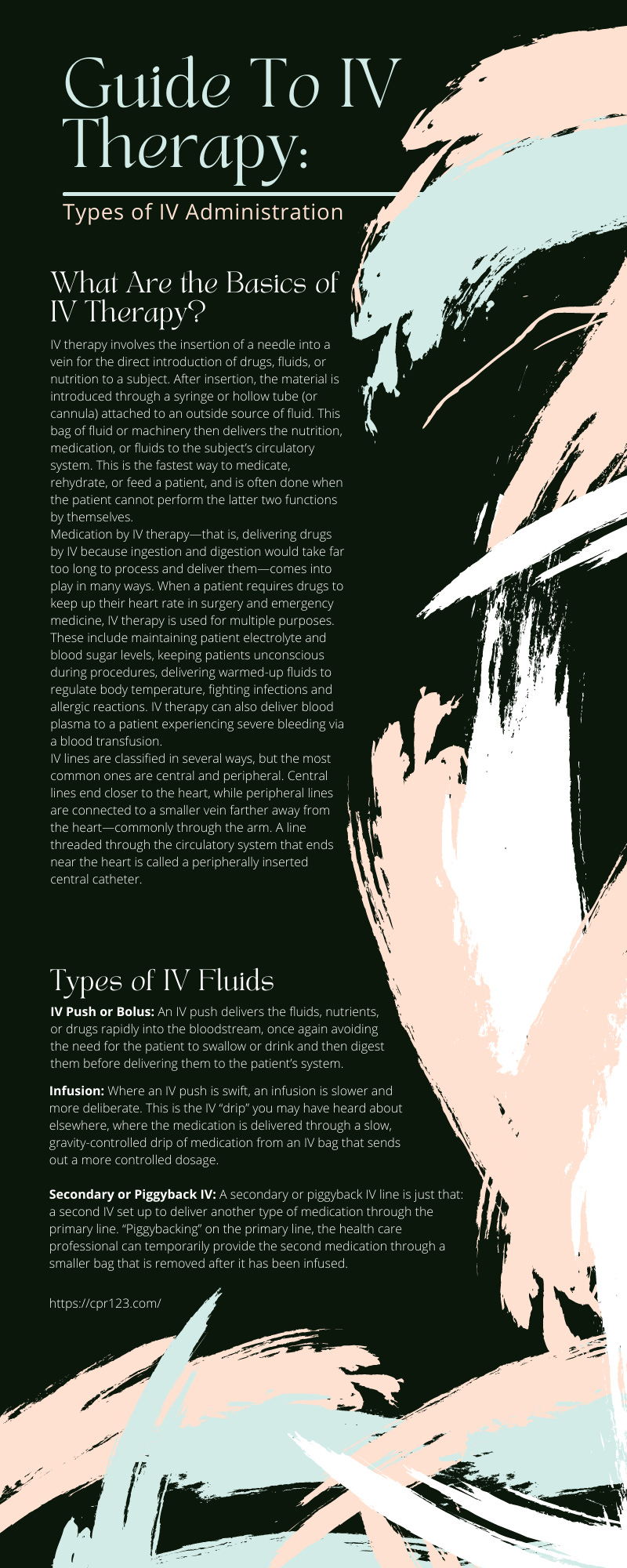Intravenous administration is one of those human inventions that not only revolutionized a field, namely healthcare, but also affected human history as well. Used to deliver everything from medicine to nutrition to vital and necessary fluids, intravenous (shortened to IV) administration was a dream of the medical profession for centuries. However, the practice only became safe and feasible sometime in the 20th century because of a series of medical innovations. But what exactly is involved with IV therapy, how is it used, and who uses it? To help clear up these and other questions, here’s a simple guide to IV therapy and the types of IV administration.
What Are the Basics of IV Therapy?
IV therapy involves the insertion of a needle into a vein for the direct introduction of drugs, fluids, or nutrition to a subject. After insertion, the material is introduced through a syringe or hollow tube (or cannula) attached to an outside source of fluid. This bag of fluid or machinery then delivers the nutrition, medication, or fluids to the subject’s circulatory system. This is the fastest way to medicate, rehydrate, or feed a patient, and is often done when the patient cannot perform the latter two functions by themselves.
Medication by IV therapy—that is, delivering drugs by IV because ingestion and digestion would take far too long to process and deliver them—comes into play in many ways. When a patient requires drugs to keep up their heart rate in surgery and emergency medicine, IV therapy is used for multiple purposes. These include maintaining patient electrolyte and blood sugar levels, keeping patients unconscious during procedures, delivering warmed-up fluids to regulate body temperature, fighting infections and allergic reactions. IV therapy can also deliver blood plasma to a patient experiencing severe bleeding via a blood transfusion. Elsewhere, people who require regular medication by IV can be fitted with a catheter, so they don’t have to repeatedly experience the pain of the needle being inserted. Finally, contrast agents can be administered via IV to allow greater visibility of parts during a medical imaging process.
IV lines are classified in several ways, but the most common ones are central and peripheral. Central lines end closer to the heart, while peripheral lines are connected to a smaller vein farther away from the heart—commonly through the arm. A line threaded through the circulatory system that ends near the heart is called a peripherally inserted central catheter. Finally, a tunneled line is a catheter inserted into a vein through the chest. All told, intravenous therapy performs an incredible number of functions in keeping or otherwise helping people stay healthy. But what are the different types of intravenous fluids, how are they delivered, and who performs these procedures?
Types of IV Fluids
IV bags can be filled with any number of medicines, usually in combination with saline solution. Saline solution is a mixture of water and sodium chloride commonly known as salt. IV bags used to deliver medications almost always include saline to carry and deliver them, but other combinations and mixtures can also be used. Saline solutions can also carry either crystalloids or colloids. Crystalloids consist of smaller molecules that can permeate and penetrate organs at the cellular level and are used to deliver materials that need to spread throughout the body’s organs. On the other hand, colloids are larger and are intended to remain in the bloodstream for multiple purposes, such as to expand blood volume.
For intravenous therapy, saline is sometimes prescribed on its own to rehydrate a patient, though a solution of dextrose and water may also be used at times. Sometimes a half saline solution is used in combination with dextrose, usually to replace fluids while providing a basic level of carbohydrate calories. Another type of IV fluid is lactated Ringer’s, which may also be used to replace fluids in patients with low blood pressure or low blood volume.
Returning to differences between colloids and crystalloids, these solutions come in three types: isotonic, hypotonic, or hypertonic. Isotonic don’t cause shrinkage or enlargement of cells because the solute concentrations are different from a patient’s cells. Hypotonic solutions have lower solute concentrations, causing water to rush in and expand cells. Cells won’t expand or shrink with an isotonic solution, while hypertonic solutions cause water to leave cells and shrink them down. Now, let’s discuss the various methods of IV medication administration.
IV Push or Bolus
An IV push or bolus happens when a single dose of medication or other fluids is swiftly injected, or pushed, into the catheter. The IV line is then flushed afterward. An IV push delivers the fluids, nutrients, or drugs rapidly into the bloodstream, once again avoiding the need for the patient to swallow or drink and then digest them before delivering them to the patient’s system. Often, drugs need to be delivered this way because it either speeds up the delivery of the dose, or because once digested, drugs lose their effectiveness. With IV push or bolus, the effects are often seen immediately. For reference, you can probably recall the doctors on a medical procedural show prescribing the pushing of some type of medication.
Infusion
Where an IV push is swift, an infusion is slower and more deliberate. This is the IV “drip” you may have heard about elsewhere, where the medication is delivered through a slow, gravity-controlled drip of medication from an IV bag that sends out a more controlled dosage.
Secondary or Piggyback IV
A secondary or piggyback IV line is just that: a second IV set up to deliver another type of medication through the primary line. “Piggybacking” on the primary line, the health care professional can temporarily provide the second medication through a smaller bag that is removed after it has been infused. This doesn’t interfere with the ongoing IV therapy and spares the patient the pain and inconvenience of being repeatedly stuck with needles and catheters.
Want To Learn More?
Hopefully, you learned about the IV basics and the different types of IV administration in our guide to IV therapy. If you want to learn more or investigate the possibilities of IV administration training, please look through our site or contact us for more information on our training and courses.








